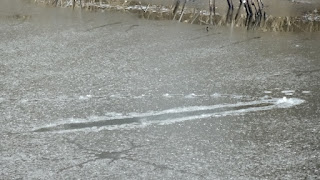Many plants, which bloom and fruit in the warm growing season, stand bravely throughout the winter to ensure its seeds are fully distributed. This fruit capsule opened as it dried out in Autumn, and seeds have been coaxed out by the breeze. Now, it stands despite snow and hoarfrost.
Velvetleaf Abutilon theophrasti blooms in late summer with orange-yellow flowers on stems and leaves that really look and feel like they are cloaked in velvet. There were a few growing in the riparian buffer around the pond, but we pulled them because this plant is not native. It can form dense monocultures in place of native plants, suck large quantities of water and nutrients from the soil, and can inhibit germination of other plants.This in one of the plants that probably spreads from nearby crop fields, and that we try to keep out of the pond area.























